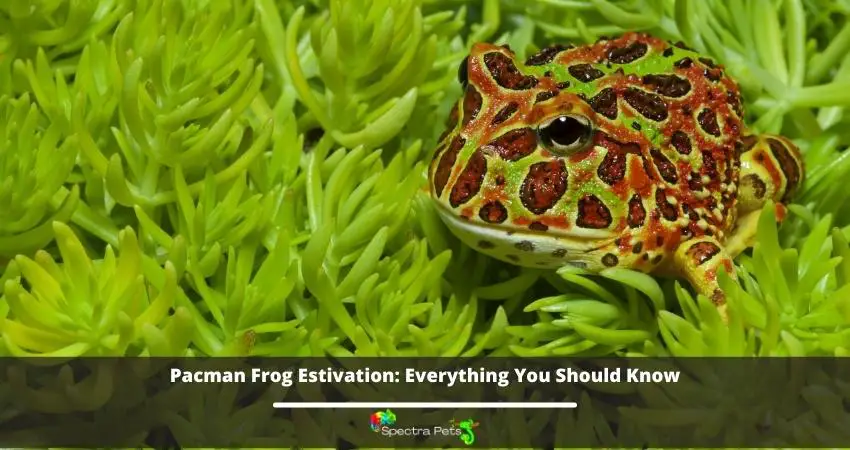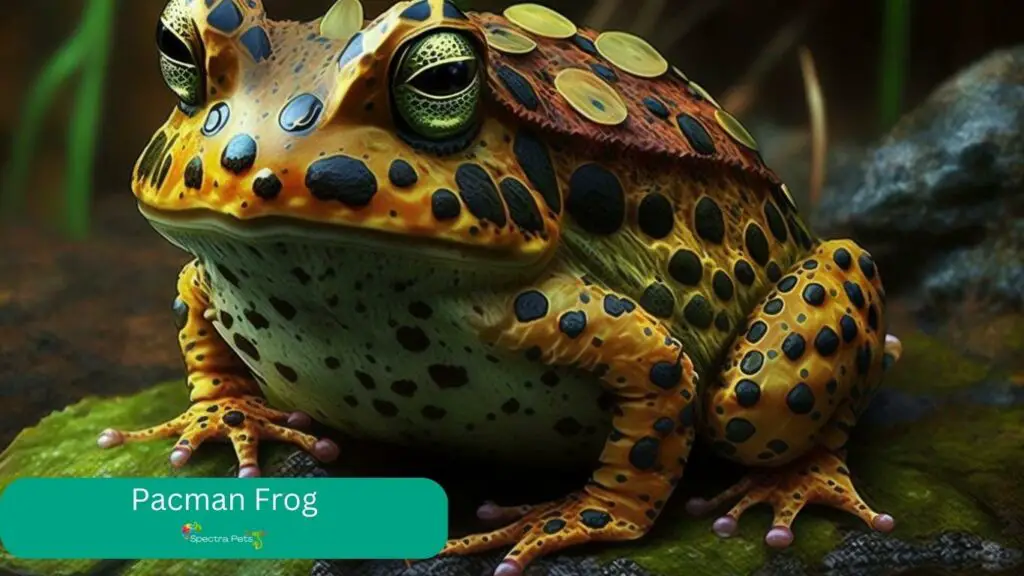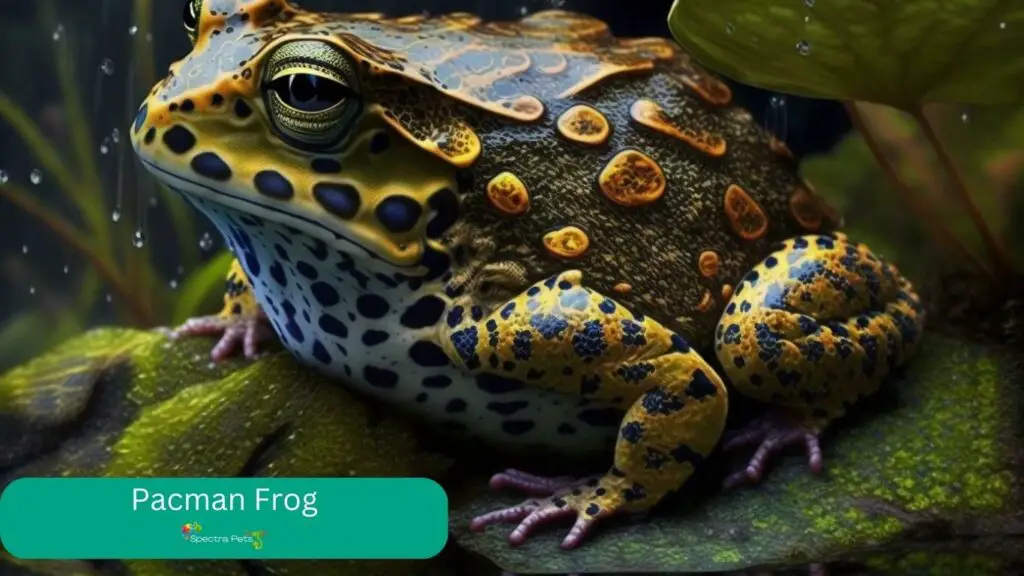Estivation is a natural process where almost all types of amphibians choose to become completely inactive for some days or even months during their lifecycle. The estivation of Pacman frogs can be a totally new experience for those who are keeping a pet frog for the first time.
Due to inadequate knowledge, beginners often make terrible mistakes when their Pacman frogs start hibernating. They tend to panic and try to provide various medications thinking the life of their pet is at risk. Your small friend could suffer from several health problems if you take inappropriate steps during his estivation.
I guess now you can easily anticipate how crucial it is for you to learn every single piece of information regarding Pacman frog estivation. So, keep reading and you will get what you want.
What Does Pacman frogs’ Estivation or Hibernation Mean?
You might already have a small idea of what estivation, it goes by another name- Hibernation, rings a bell?

Animals like frogs adopt various strategies to cope with the diverse climate changes. Hibernation AKA Estivation is one such reaction your Pacman frog may show while encountering the cold times of the year.
During Estivation, a Pacman frog creates a hibernaculum (protective layer). This hiding space helps them survive the freezing winter season. Pacman frogs typically sleep away during these cold months as their metabolism slows during these months.
However, when the warmth of the spring starts knocking at the door, these cute guys wake up and come out of their hibernation state. As their lives return to normal, they continue to eat, breed, and enjoy.
What are the reasons that lead Pacman Frogs to Estivation?
While living in the wild, Pacman frogs choose to hibernate almost every year, especially in winter times. As they are cold-blooded creatures, they love hot and humid temperatures and that’s why they are found in tropical regions with high humidity levels. So, when the winter arrives, they act quickly and go to the estivation state to survive those unwanted cold days.
However, a Pacman frog in captivity may not feel the urge to slumber if the temperature in its tank is kept optimal. In contrast, failing to keep a consistent climate inside the terrarium may encourage your Pacman frog to go into a state of dormancy.
Also, you might experience your Pacman frog attempting to do estivation due to inappropriate soil moisture levels. Moreover, your frog may enter estivation if the tank’s humidity is not maintained at around 80%.
Common Signs of Pacman Frogs’ Hibernation
Though estivation is a natural process, Pacman frogs aged below 12 months shouldn’t be allowed to aestivate as many young frogs lose a huge amount of body mass during this process.
The most alarming fact is that a young Pacman could die while in hibernation since it has a negative impact on his body.
So, I think it’s vital for a frog owner to know the signs a frog shows before going into dormancy so that they can take proper measures to stop the young ones from hibernating. Here are the signs you should know –
1. Having no appetite
Pacman frogs like to eat whatever fits inside their mouth. It’s one of their favorite things to fill their stomachs every time. But, you may witness a different scenario if your frog intended to go into hibernation.
Hence, Pacman frogs may try to hibernate when they don’t seem to be interested in eating, despite not experiencing any health problems.
2. Forming dry skin
Just before starting the estivation period, a frog creates a dry shell-like skin around the outer part of their body. This dry cocoon is a clear indication that the frog is going to hibernate.
Pacman frogs shed this old dry skin naturally, but they decide to keep this skin as a protective layer before going into dormancy.
3. Slow movement
If you observe your frog isn’t moving as much as it used to, then it’s a sign that he’s trying to slow down his body’s metabolism before going into hibernation. A frog needs to burn a lot of energy to stay active and hunt for food.
But, since a Pacman frog doesn’t eat during hibernation, he tries to conserve as much energy as possible by slowing down his movement.
4. Burrowing
When a Pacman frog is about to hibernate, he starts digging a hole in the ground using his hind legs. He does this to create a safe place for himself where he can estivate for a long time without any disturbance.
5. Sleeping for a long time
Pacman frogs increase their sleeping hours before going into hibernation. They may sleep for more than usual. Actually, the increased sleep is a way to prepare their body for the long dormancy period.
These are some of the most common signs that your Pacman frog is going to hibernate. If you see your young frog showing any of these signs, then it’s time to take some measures to stop him from going into dormancy.
Read More: How Do I know If My Pacman Frog is Dying?

How to stop young frogs from going into hibernation?
If you notice any of the above-mentioned changes in your young frog’s behavior, then it’s time to take some measures to stop him from being estivating. Some of the things you can do to prevent your Pacman frog from hibernating are-
1. Provide a warm temperature and humidity level
You can create a warm environment for your Pacman frog. The ideal temperature for a Pacman frog is between 75 to 80 degrees Fahrenheit at night and 82 to 85 degrees Fahrenheit during the day.
You can use a hygrometer to measure and maintain the temperature and humidity levels in your frog’s enclosure.
Moreover, the ideal humidity level for a Pacman frog is 80%. If the humidity level drops below this, then your frog may start to estivate.
2. Give your frog a soak
If your young frog goes under the substrate and stays there for too long, he may start to estivate. So, it’s important to dig him up and place him in a warm de-chlorinated soak.
Also, you can give him a honey bath. For that, mix 3–4 drops of honey in the water. Pedialyte bath is also a good idea. This bath consists of a ratio of 1 oz unflavored Pedialyte to 10 oz of clean water.
3. Change the substrate
The substrate you use can also affect your frog’s estivation behavior. If you’re using a substrate that doesn’t hold moisture well, then it can cause the humidity levels to drop, which may lead to your frog going into estivation.
So, it’s important to change the substrate and use one that holds moisture well.
4. Take the frog to a vet
If your young frog is going into estivation, and you’re not sure what to do, then the best thing you can do is take him to a vet. The vet will be able to check if there are any medical conditions that are causing the estivation. Also, the vet may give the frog an antibiotic like Baytril injection that can help to spark the frog’s appetite.
How long does a Pacman Frog Estivate for?
While living in the wild, a Pacman Frog will spend the freezing winter months in the state of dormancy. During estivation, the frog will burrow into the ground and will stay there until the temperature outside rises. So, when the warmer spring comes around, the Pacman Frog will begin to return to their usual activity.
However, in captivity, a Pacman Frog will not estivate because the temperature does not drop low enough for them to enter into the dormancy state.
Make sure that you provide your captive Pacman Frog with an optimal habitat, including a temperature range of 75 to 85 degrees Fahrenheit, high humidity, and moist substrate.

What benefit does estivation bring to the Adult Pacman frog?
As a semiaquatic creature, Pacman frogs spend the majority of time on land but enter the water to mate and lay eggs. Estivation is a crucial part of a frog’s life. Though estivation is not good for young frogs aged below 12 months, it is good for adult frogs, especially those who are living in the wild.
During the dry winter season, adult Pacman frogs hibernate in order to escape the harsh conditions. As a means of surviving periods of extreme cold or dryness, these frogs will bury themselves in mud or debris and essentially go into a state of dormancy. When conditions improve, they will emerge from estivation and return to their normal activities.
Another benefit of estivation is that it allows the frog to escape from predators during harsh weather conditions. In addition to that, it conserves the frog’s energy and slows down metabolism, as the frog does not eat or drink during this period.
Moreover, hibernation helps the frog to survive hostile situations so that it can mate and lay eggs in more favorable conditions after emerging from hibernation.
How can I help my Pacman frog during hibernation?
During hibernation, Pacman frogs will lower their heart rate and body temperature, and enter into a state of suspended animation. In some cases, frogs even die while doing estivation. So, you should play your part properly. Well, you can do the following 3 things to help ensure that your Pacman frog has a successful hibernation period.
- You’ll need to provide favorable humidity and temperature levels in order to encourage your frog to come out of hibernation.
- It’s important to keep the tank clean so that your frog has a clean and safe place to return to. You can also change the substrate too.
- Be sure to provide a dish of water for your frog to take a bath and peel off the skin cocoon when it wakes up.
By following these simple tips, you can help ensure that your Pacman frog has a successful hibernation period.
Is it a good idea to wake up my Pacman frog from Estivation?
In the wild, Pacman frogs decide to go into dormancy to tackle the awkward situations they are undergoing. And, as soon as everything becomes normal, they return to their normal lives. So, this is a normal natural process and nobody should interfere with this process.
However, in captivity, the hibernation tendency isn’t good for Pacman frogs. They might choose to Estivate for long periods and might not return to their normal life, which ultimately leads to death. So, in that case, it is advisable not to take the necessary steps to encourage your frog to wake up from Estivation.
How cold is too cold for Pacman frogs?
Pacman frogs love hot and humid conditions. In captivity, tank temperature below 65° F will be too cold for Pacman frogs. So, it is recommended to maintain a temperature of 75 to 80 degrees Fahrenheit during the day and 65 to 70 degrees Fahrenheit during the night.
How do I know if my Pacman frog is hibernating or Dying?
There are a few things you can look for to determine whether your Pacman frog is dying or hibernating. If your frog has lost a lot of weight and is inactive, then it’s likely in hibernation. Likewise, if your frog is unresponsive, forming a dry cocoon-like skin, and has stopped eating, it’s also likely in hibernation. Don’t panic outright in these cases.
However, if your frogs don’t come out from hibernation despite getting optimal survival conditions, they might be dying due to some other issues. So, you need to take them to the vet immediately.
Final Words
By now you should have a better understanding of Pacman frog’s estivation after reading so many important things about it. Always remember that frogs below 12 months old shouldn’t be allowed to hibernate as many young frogs never came out from estivation. And, if your frog shows any signs of going into dormancy, encourage him/her to change the decision by providing a favorable environment.
